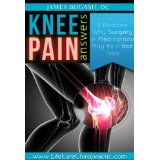The more astute of us are rightfully concerned with developing arthritis as we age. Luckily, this is not a foregone conclusion.
Most people incorrectly think that injury to a joint is the only major factor that leads to the later development of arthritis in that joint. While any injury to a joint is an important player, there are other factors at play.
(I also have patients who state that his or her left knee pain is just from old age. At this point I ask how much older it is than the other knee…)
For arthritis of the spine related to disc degeneration, we have known for a long time that a lifestyle that is pro-heart disease will also increase your risk for disc degeneration and spinal arthritis. The reason for this is simple—discs do not have their own blood supply. Instead, they are fed indirectly by small blood vessels. If these small blood vessels become filled with plaque, they can no longer deliver needed nutrients to the discs. With normal use, these discs will break down because they can’t meet the demands of daily life.
The surfaces of your joints are not too much different. Poor blood vessel health will lower the ability of your joint surfaces to get the nutrients they need to respond to day to day demands.
This means that a lifestyle that is designed to protect your heart will also protect your joints. Pretty cool. NOT killing two birds with one stone, so to speak.
This particular study may give us even more insight into how we can protect our joints. In it, researchers looked at the ability of different types of fats (specifically saturated fats, omega 3 and omega 6 fatty acids) to protect against damage to the medial meniscus of the knees of mice.
They found that saturated fats and omega 6 fatty acids did not protect against the later development of osteoarthritis and even increased the amount of arthritis that resulted, they increased extra bone formation around the joint (a hallmark of osteoarthritis) and increased scar formation.
Let me put this more plainly: The dietary choices you make WILL absolutely increase the damage to your joints that occurs with an injury, leading to more osteoarthritis in your joints years later.
Luckily, the omega 3 fatty acids were a different story.
The omega 3 fatty acids were able to enhance wound repair as well as lower the risk of later development of arthritis. Pretty cool that diet can play this powerful of a role.
In case you need a refresher on which fats to avoid, here’s some help:
- The main source of saturated fats include fats contained in our society’s poorly raised livestock.
- Omega 6 fatty acids are found in certain oils like corn, sunflower, soybean and peanut oils.
- Omega 3 fatty acids are found in nuts, seeds (such as flax), wild caught fish and game, certain grains (salba, quinoa as examples) and grass fed beef.
Just by making smart dietary choices combined with maintaining an ideal body weight and staying active you can go a long way towards protecting your joints for years to come.
Is would also seem that, just in case all the other things that they are good for has not been enough, fish oils supplements would play a role in preventing osteoarthritis, especially after injury.
Osteoarthritis is NOT something that has to happen to your joints. Think about that the next time you reach for that bag of chips…

